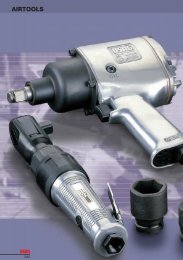Industrial seal self study guide - SKF.com
Industrial seal self study guide - SKF.com
Industrial seal self study guide - SKF.com
You also want an ePaper? Increase the reach of your titles
YUMPU automatically turns print PDFs into web optimized ePapers that Google loves.
Speedi-Sleeve Installation<br />
Speedi-Sleeves are available for shaft diameters ranging from .469”<br />
up to 8.005” (11.91 to 203.33mm). Each Speedi-Sleeve kit contains a<br />
disposable installation tool and every box is marked with the shaft<br />
range for proper selection.<br />
Follow these <strong>guide</strong>lines for proper Speedi-Sleeve installation:<br />
1. Clean the surface where the <strong>seal</strong> contacts the shaft.<br />
File down and polish any burrs, nicks or rough spots.<br />
Make sure the end is free of nicks and burrs.<br />
2. Measure an unworn portion of the shaft where the sleeve<br />
will be positioned. Do not install Speedi-Sleeve over keyways<br />
or splines unless their diameter is under nominal<br />
shaft size. Measure in three positions and average the<br />
reading, in case the shaft is out of round. If the average<br />
diameter is within the range for a given Speedi-Sleeve,<br />
there is sufficient press-fit built into the sleeve to keep it<br />
from sliding or spinning. No cement is necessary.<br />
3. If the groove does not require filling, optionally a light<br />
layer of non-hardening <strong>seal</strong>ant can be applied to the inner<br />
surface of the sleeve.<br />
4. If the shaft is deeply scored, fill the groove with powdered<br />
metal epoxy type filler. Install Speedi-Sleeve before the<br />
filler hardens.<br />
5. Speedi-Sleeves are wide enough to cover the wear pattern<br />
of both standard and wider <strong>com</strong>bination <strong>seal</strong>s. Where extra<br />
wide <strong>com</strong>binations are encountered, a second sleeve can be<br />
installed to butt against the first. The flange is then peeled<br />
off to provide the clearance necessary for the <strong>seal</strong> housing<br />
to slide into place. The Speedi-Sleeve installation flange can<br />
be left in place unless it could prevent oil from reaching the<br />
<strong>seal</strong> lip.<br />
6. Determine how far back the sleeve must be positioned to<br />
cover the old <strong>seal</strong> wear tracks. Measure to the exact point,<br />
or mark directly on the shaft surface (fig. 6e).<br />
7. The sleeve must be placed over the worn surface area, not<br />
just bottomed or left flush with the end of the shaft.<br />
Place flanged end of Speedi-Sleeve<br />
onto shaft first. (fig. 6e).<br />
…then apply the installation<br />
tool over the sleeve and<br />
against the flange… (fig. 6f).<br />
6<br />
55







